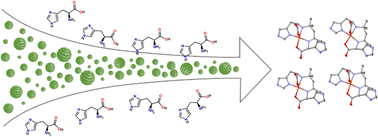Engineering copper plasmonic chirality via ligand-induced dissolution for enantioselective recognition of amino acids†
Abstract
The formation of chiral nanosystems and their subsequent enantioselective interaction with chiral amino acids are vital steps in many biological processes. Due to their potential to mimic biological systems, the synthesis of chiral nanomaterials has garnered significant attention over the years. Despite the emergence of diverse nanomaterials showcasing strong chiral responses, the in-depth understanding of the mechanism of plasmonic chirality in copper nanoparticles and their subsequent application in various fields are least explored. Herein, we demonstrate a facile approach for the synthesis of chiral copper nanoparticles using cysteine as a chiral precursor and capping ligand. Ligand-mediated chiral induction, established through experimental findings and a theoretical model, is ascribed as the major contributor to the origin of plasmonic chirality. The enantioselective recognition of chiral copper nanoparticles towards histidine, an amino acid with vast biological functions, was meticulously investigated by leveraging the strong copper–histidine binding ability. Ligand-induced dissolution, a unique phenomenon in nanoparticle reactions, was identified as the underlying mechanism for the nanoparticle-to-complex conversion. Understanding the mechanism of chiral induction in copper nanoparticles coupled with their enantioselective recognition of biomolecules not only holds promise in biomedical research but also sheds light on their potential as catalysts for asymmetric synthesis.



 Please wait while we load your content...
Please wait while we load your content...